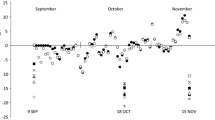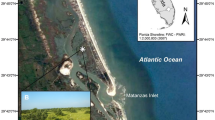Abstract
Freeze/thaw stress was examined in chaparral shrubs of the genus Ceanothus to determine the interactive effects of freezing and drought and to consider which is the more vulnerable component, the living leaves (symplast) or the non-living water transport system (apoplast). We hypothesized that where Ceanothus species co-occurred, the more inland species C. crassifolius would be more tolerant of low temperatures than the coastal species C. spinosus, both in terms of leaf survival (LT50, or the temperature at which there is 50% loss of function or viability) and in terms of resistance to freezing-induced embolism (measurements of percent loss hydraulic conductivity due to embolism following freeze/thaw). Cooling experiments on 2 m long winter-acclimated shoots resulted in LT50 values of about –10°C for C. spinosus versus –18°C for C. crassifolius. Freeze-thaw cycles resulted in no change in embolism when the plants were well hydrated (−0.7 to –2.0 MPa). However, when plants were dehydrated to –5.0 MPa, C. spinosus became 96% embolized with freeze/thaw, versus only 61% embolism for C. crassifolius. Stems of C. crassifolius became 90% and 97% embolized at –6.6 and –8.0 MPa, respectively, meaning that even in this species, stems could be more vulnerable than leaves under conditions of extreme water stress combined with freeze/thaw events. The dominance of C. crassifolius at colder sites and the restriction of C. spinosus to warmer sites are consistent with both the relative tolerance of their symplasts to low temperatures and the relative tolerance of their apoplasts to freeze events in combination with drought stress.






Similar content being viewed by others
References
Boorse GC, Ewers FW, Davis SD (1998a) Response of chaparral shrubs to below-freezing temperatures: acclimation, ecotypes, seedlings vs adults. Am J Bot 85:1224–1230
Boorse GC, Bosma TL, Meyer A-C, Ewers FW, Davis SD (1998b) Comparative methods of estimating freezing temperatures and freezing injury in leaves of chaparral shrubs. Int J Plant Sci 159:513–521
Davis SD, Kolb KJ, Barton KP (1998) Ecophysiological processes and demographic patterns in the structuring of California chaparral. In: Rundel PW, Montenegro G, Jaksic F (eds) Landscape disturbance and biodiversity in Mediterranean-type ecosystems, vol 136. Springer, Berlin Heidelberg New York, pp 297–310
Davis SD, Ewers FW, Wood J, Reeves JJ, Kolb KJ (1999a) Differential susceptibility to xylem cavitation among three pairs of Ceanothus species in the transverse mountain ranges of southern California. Ecoscience 6:180–186
Davis SD, Sperry JS, Hacke UG (1999b) The relationship between xylem conduit diameter and cavitation caused by freezing. Am J Bot 86:1367–1372
Davis SD, Ewers FW, Sperry JS, Portwood KA, Crocker MC, Adams GC (2002) Shoot dieback during prolonged drought in Ceanothus (Rhamnaceae) chaparral of California: a possible case of hydraulic failure. Am J Bot 89:820–828
Harrison T (1996) Trail map of the Santa Monica Mountains Central. Tom Harrison Cartography, San Rafael, Calif.
Hickman JC (1993) The Jepson manual. University of California Press, Berkeley
Kolb KJ, Davis SD (1994) Drought-induced xylem embolism in co-occurring species of coastal sage and chaparral of California. Ecology 75:648–659
Langan S J, Ewers FW, Davis SD (1997) Xylem dysfunction caused by water stress and freezing in two species of co-occurring chaparral shrubs. Plant Cell Environ 20:425–437
Martínez-Vilalta J, Pockman WT (2002) The vulnerability to freezing-induced xylem cavitation of Larrea tridentate (Zygophllaceae) in the Chihuahuan desert. Am J Bot 89:1916–1924
Miller PC, Poole DK (1979) Patterns of water use in shrubs in southern California. For Sci 25:84–98
Pockman WT, Sperry JS (1997) Freezing-induced xylem cavitation and the northern limit of Larrea tridentata. Oecologia 109:19–27
Sakai A, Larcher W (1987) Frost survival of plants. Ecological Studies 62. Springer, Berlin Heidelberg New York
Scholander PF, Hammel HT, Bradstreet ED, Hemmingsen EA (1965) Sap pressure in vascular plants. Science 148:339–346
Shreve F (1914) The role of winter temperatures in determining the distribution of plants. Am J Bot 1:194–202
Sperry JS, Donnelly JR, Tyree MT (1988) A method for measuring hydraulic conductivity and embolism in xylem. Plant Cell Environ 11:35–40
Thomas CM, Davis SD (1989) Recovery patterns of three chaparral shrub species after wildfire. Oecologia 80:309–320
Wieslander AE (1930–1934) A vegetation type map of California, Santa Monica Mountains, Malibu. U.S. Forest Service, California
Wieslander AE (1961) California's vegetation maps. Recent Advances in Botany, University of Toronto Press, Toronto, 1402–1405
Williams JE, Davis SD, Portwood KA (1997) Xylem embolism in seedlings and resprouts of Adenostoma fasciculatum after fire. Aust J Bot 45:291–300
Acknowledgements
Sincere thanks to Mike Takeshita and Bradley Yocum of the Malibu Forestry Unit of Los Angeles County for assistance with field work and weather data, and to Brandon Pratt for critical review of the manuscript. This work was funded by NSF Grants BIR-9225034 and IBN-950753.
Author information
Authors and Affiliations
Corresponding author
Rights and permissions
About this article
Cite this article
Ewers, F.W., Lawson, M.C., Bowen, T.J. et al. Freeze/thaw stress in Ceanothus of southern California chaparral. Oecologia 136, 213–219 (2003). https://doi.org/10.1007/s00442-003-1273-9
Received:
Accepted:
Published:
Issue Date:
DOI: https://doi.org/10.1007/s00442-003-1273-9




